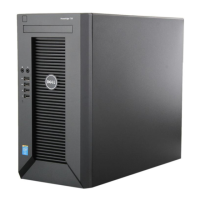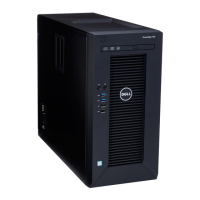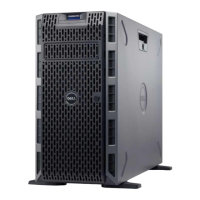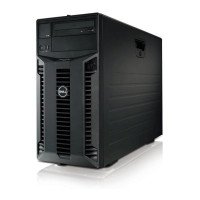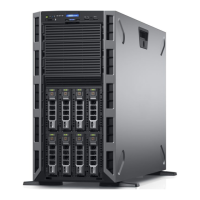







Do you have a question about the Dell PowerEdge T710 and is the answer not in the manual?
Provides methods to access system features during startup.
Details the system's front panel components and their indicators.
Explains the functionality and display of the system's LCD panel.
Illustrates and describes indicators for hard drive status.
Details the system's back panel components and their indicators.
Provides instructions for connecting external devices to the system.
Explains the meaning of different NIC indicator light codes.
Details the status indicators for power supplies and the power button.
Lists LCD error codes, their causes, and corrective actions.
Lists system messages, their causes, and corrective actions.
Explains warning messages that alert to potential problems.
Mentions messages issued by system diagnostic utilities.
Describes alert messages generated by systems management software.
Lists additional resources for system information and support.
Explains how to select between BIOS and UEFI boot modes.
Provides step-by-step instructions to enter the system setup utility.
Lists and describes various configuration options in System Setup.
Details options for configuring system memory size, type, and speed.
Lists options for configuring processor features like speed and virtualization.
Provides options to enable/disable the integrated SATA controller and ports.
Allows selection of boot mode (BIOS/UEFI) and boot sequence.
Options to enable/disable integrated devices like USB, NICs, and SD card.
Options for configuring serial ports and console redirection.
Configures front-panel LCD options and user-defined LCD strings.
Manages power usage for processors, fans, and memory.
Configures system and setup passwords and TPM security.
Instructions to access the UEFI Boot Manager for managing boot options.
Describes options within the UEFI Boot Manager, including boot settings.
Explains how to assign and use a system password for security.
Details how to assign and use a setup password to protect BIOS settings.
Introduces the Unified Server Configurator (USC) utility for system management.
Provides steps to access the iDRAC Configuration Utility.
Lists essential tools required for system component installation.
Warns about safety procedures for internal system access.
Details the system's support for two 1100W power supplies.
Information on removing and installing the front bezel of the system.
Safety warnings and procedures for opening and closing the system cover.
Explains the function of the cooling shroud and how to remove it.
Discusses system configurations and types of hard drives supported.
Information on supported optical and tape drives.
Discusses supported memory types, speeds, and capacities.
Discusses processor installation and upgrades.
Information on supported expansion cards and slots.
Information on installing and removing the internal SD module.
Instructions for installing and removing an internal SD flash card.
Information on installing and using an internal USB memory key.
Information on installing the NIC hardware key.
Information on removing and installing the RAID battery.
Information on removing and installing the chassis intrusion switch.
Details the integrated storage controller card and its functions.
Information about the system's cooling fan modules.
Information on the fan cage and its removal.
Information on VFlash media used with iDRAC6.
Information on the iDRAC6 Enterprise card.
Information on replacing the system battery.
Procedures for control panel assembly replacement.
Information on SAS backplane removal.
Information on system board replacement.
Information on power distribution board replacement.
Safety precautions for working with the system.
Steps to diagnose and resolve system startup failures.
Guidance on troubleshooting external cable connections.
Steps to diagnose and resolve video subsystem issues.
Steps to troubleshoot issues with USB devices.
Steps to troubleshoot serial I/O devices.
Steps to diagnose and resolve Network Interface Card (NIC) issues.
Steps to troubleshoot issues related to a 'wet system'.
Procedures for troubleshooting a physically damaged system.
Steps to diagnose and resolve system battery issues.
Steps to diagnose and resolve power supply issues.
Identifies conditions causing system cooling problems.
Steps to diagnose and resolve issues with cooling fans.
Steps to diagnose and resolve system memory issues.
Steps to diagnose and resolve issues with internal SD cards.
Steps to diagnose and resolve issues with internal USB memory keys.
Steps to diagnose and resolve issues with optical drives.
Steps to diagnose and resolve issues with tape backup units.
Steps to diagnose and resolve issues with external tape drives.
Steps to diagnose and resolve hard drive issues.
Steps to diagnose and resolve storage controller issues.
Steps to diagnose and resolve SAS/SAS RAID controller issues.
Steps to diagnose and resolve expansion card issues.
Steps to diagnose and resolve processor issues.
Describes how to use online diagnostics for system assessment.
Lists features and capabilities of embedded system diagnostics.
Guidance on when to utilize embedded system diagnostics.
Steps to launch and run the embedded system diagnostics.
Options for conducting system diagnostics tests.
How to choose specific diagnostic tests to run.
How to view test results and related information.
Details the function and settings of system board jumpers.
Illustrates and lists system board connectors.
Diagrams and lists connectors on the SAS backplane board.
Diagrams and lists connectors on the power distribution board.
Procedure to disable system passwords using a jumper.
Provides contact methods and resources for Dell support.
| Tcase | 76 °C |
|---|---|
| Bus type | QPI |
| Stepping | D0 |
| FSB Parity | No |
| Processor code | SLBF8 |
| Processor cache | 4 MB |
| Processor cores | 4 |
| Processor model | E5506 |
| System bus rate | 4.8 GT/s |
| Processor series | Intel Xeon 5500 Series |
| Processor socket | Socket B (LGA 1366) |
| Processor codename | Nehalem EP |
| Motherboard chipset | Intel® 5520 |
| Number of QPI links | 2 |
| Processor frequency | 2.13 GHz |
| Processor cache type | Smart Cache |
| Processor lithography | 45 nm |
| Processor system type | DP |
| Processor manufacturer | Intel |
| Processor package size | 42.5 x 45 mm |
| Processor front side bus | - MHz |
| Processor operating modes | 64-bit |
| ECC supported by processor | Yes |
| Thermal Design Power (TDP) | 80 W |
| Compatible processor series | Intel® Xeon® |
| Number of processors installed | 1 |
| CPU multiplier (bus/core ratio) | 16 |
| Memory types supported by processor | DDR3-SDRAM |
| Memory channels supported by processor | Triple |
| Memory clock speeds supported by processor | 800 MHz |
| Memory bandwidth supported by processor (max) | 19.2 GB/s |
| Maximum internal memory supported by processor | 144 GB |
| HDD size | 3.5 \ |
| HDD speed | 15000 RPM |
| HDD interface | Serial Attached SCSI (SAS) |
| Optical drive type | DVD-ROM |
| Total storage capacity | 300 GB |
| Maximum storage capacity | - TB |
| Number of HDDs supported | 6 |
| Graphics card | G200 |
| Graphics card family | Matrox |
| Memory slots | 18x DIMM |
| Internal memory | 4 GB |
| Memory clock speed | 1333 MHz |
| Maximum internal memory | 192 GB |
| Memory layout (slots x size) | 2 x 2 GB |
| Networking features | Gigabit Ethernet |
| PS/2 ports quantity | 0 |
| USB 2.0 ports quantity | 8 |
| PCI Express x8 slots | 5 |
| Power supply | 1100 W |
| Number of power supply units | - |
| Compatible operating systems | Windows Small Business Server 2011 Windows Small Business Server 2008 Windows Server 2008 SP2, x86/x64 (x64 includes Hyper-V) Windows Server 2008 R2 SP1, x64 (includes Hyper-V v2) Windows HPC Server 2008 Novell SUSE Linux Enterprise Server Red Hat Enterprise Linux |
| Sustainability certificates | ENERGY STAR |
| Compliance industry standards | IEEE 802.3, IEEE 802.3u, IEEE 802.3ab |
| Chassis type | Tower (5U) |
| Processor ARK ID | 37096 |
| Depth | 731.8 mm |
|---|---|
| Width | 217.9 mm |
| Height | 466.3 mm |
| Weight | 35300 g |
